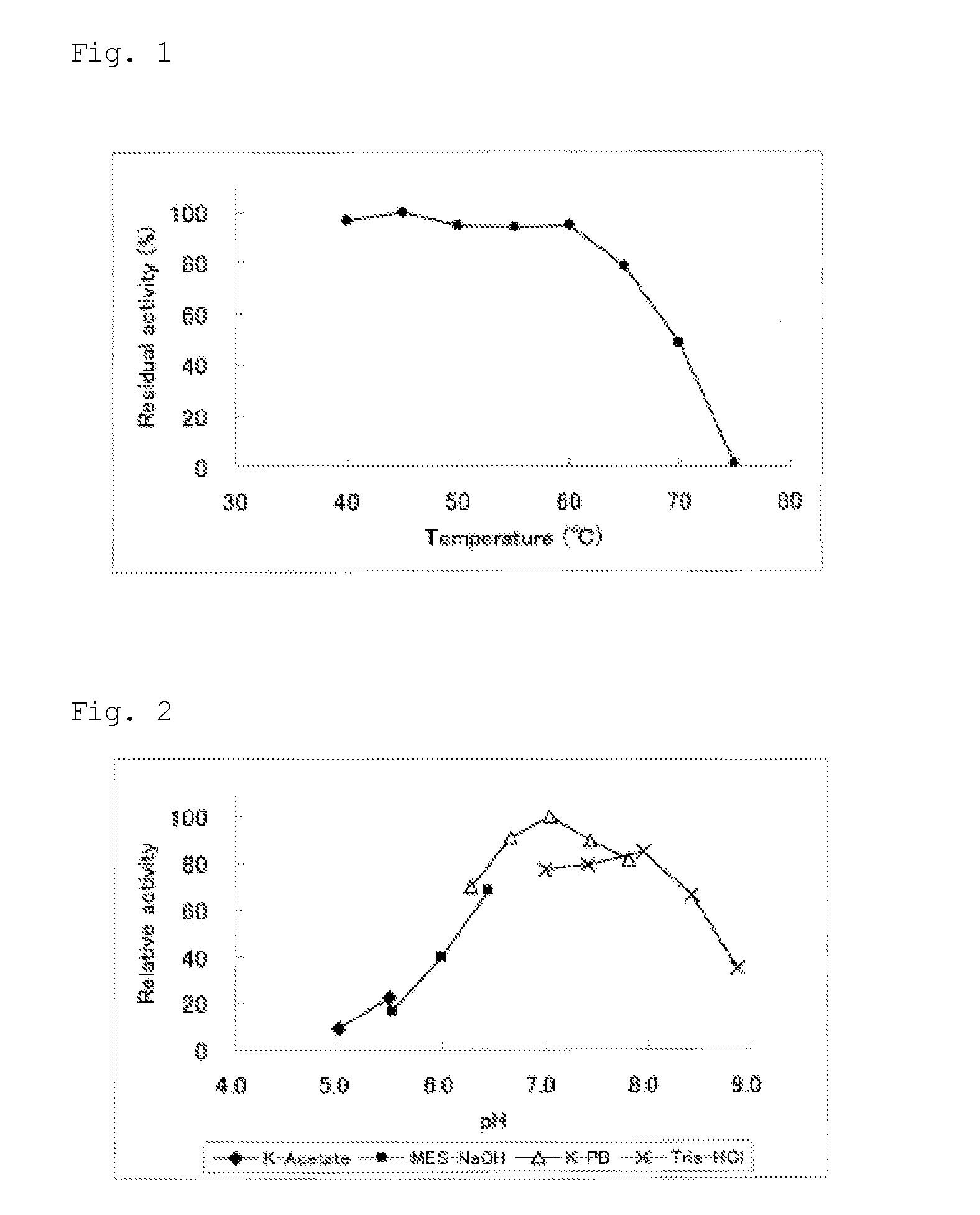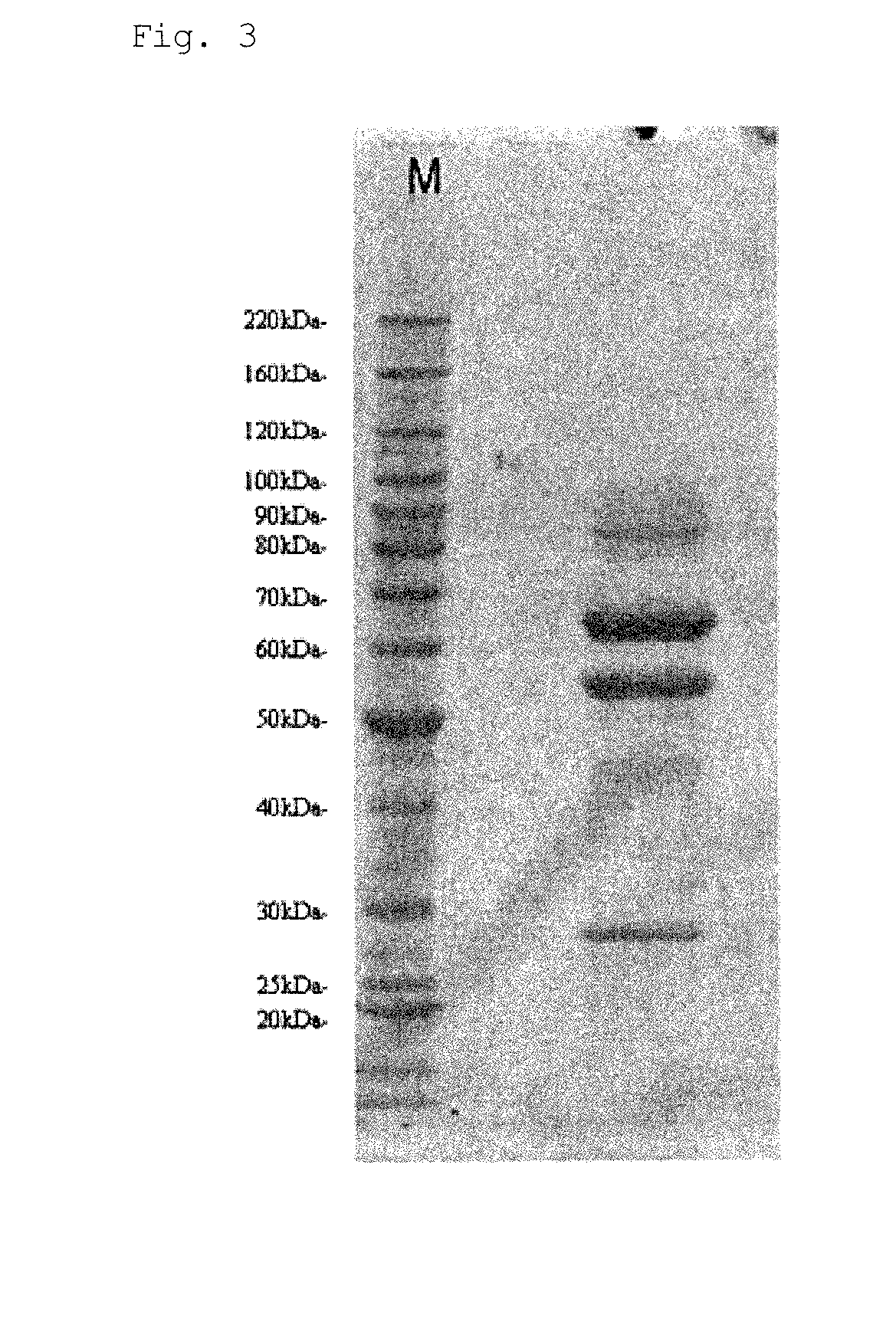Novel glucose dehydrogenase
a glucose dehydrogenase and glucose oxidase technology, applied in biochemistry, instruments, enzymology, etc., can solve the problems of high cost of reagents for quantifying glucose or sensors, inconvenient use, and high cost of quality control, and achieve low risk of deactivation and high thermal stability
- Summary
- Abstract
- Description
- Claims
- Application Information
AI Technical Summary
Benefits of technology
Problems solved by technology
Method used
Image
Examples
example 1
[0141]Obtaining GDH from the Aspergillus sp. RD009469 Strain
[0142]The Aspergillus sp. RD009469 strain was loaned by the National Institute of Technology and Evaluation. First, this strain was inoculated in an ME agar medium (2% malt extract, 0.1% peptone, 0.1% monopotassium phosphate, 2% glucose, 1.5% agarose, pH of 6.0) and cultured at 25° C. to allow the hypha to grow over the plate. All of the agarose on which the hypha was grown was scraped from the plate and suspended in 100 ml of sterilized water. The agar suspended in 6 L of a YM medium (3% yeast extract, 3% maltose, 0.05% Adeka Nol) was placed in a 10-L jar fermenter, and aeration-agitation culture was performed at 25° C. for 65 hours. After the culture, the GDH activity in the medium supernatant was measured, and activity of 0.2 U / ml was detected. After the culture medium was filtered through filter paper to remove the cells, ammonium sulfate was added in an amount of 300 g per L. After complete dissolution, a 20% sodium hy...
example 2
Thermal Stability of GDH
[0143]The GDH obtained in Example 1 was diluted with a 50 mM potassium phosphate buffer (pH of 6.0) so that the GDH concentration was 2 U / ml. The resulting solutions were subjected to heat treatment for 15 minutes at each temperature from 40° C. to 70° C. in 5° C., increments, and the ratio of the GDH activity after heating to the GDH activity before heating (residual activity) was investigated. FIG. 1 shows the results. The residual activity of the GDH after heating was 94.5% at 60° C., 78.8% at 65° C., and 48.6% at 70° C.
example 3
[0144]pH-Dependence of GDH Activity
[0145]The pH dependence of GDH activity regarding the GDH obtained in Example 1 was investigated as follows. Measurement liquids having various pHs ranging from 5.0 to 9.0 were prepared by using various buffers instead of 0.1 mol / L HEPES in the composition described in the activity measurement example above. The buffers used were potassium acetate (pH of 5.0 to 5.5), MES-NaOH (pH of 5.5 to 6.5), potassium phosphate (pH of 6.0 to 8.0), and Tris-HCl (pH of 7.0 to 9.0). The concentrations of the buffers in the measurement liquids were all 70 mM. The GDH activity at each pH was measured using each measurement liquid according to the procedure as described in the activity measurement example above. The relative activity at each pH was calculated with the activity value at conditions showing the highest activity taken as 100 (FIG. 2). The optimum reaction pH was about 7.0.
PUM
| Property | Measurement | Unit |
|---|---|---|
| temperatures | aaaaa | aaaaa |
| temperatures | aaaaa | aaaaa |
| heat resistance | aaaaa | aaaaa |
Abstract
Description
Claims
Application Information
 Login to View More
Login to View More - R&D
- Intellectual Property
- Life Sciences
- Materials
- Tech Scout
- Unparalleled Data Quality
- Higher Quality Content
- 60% Fewer Hallucinations
Browse by: Latest US Patents, China's latest patents, Technical Efficacy Thesaurus, Application Domain, Technology Topic, Popular Technical Reports.
© 2025 PatSnap. All rights reserved.Legal|Privacy policy|Modern Slavery Act Transparency Statement|Sitemap|About US| Contact US: help@patsnap.com


